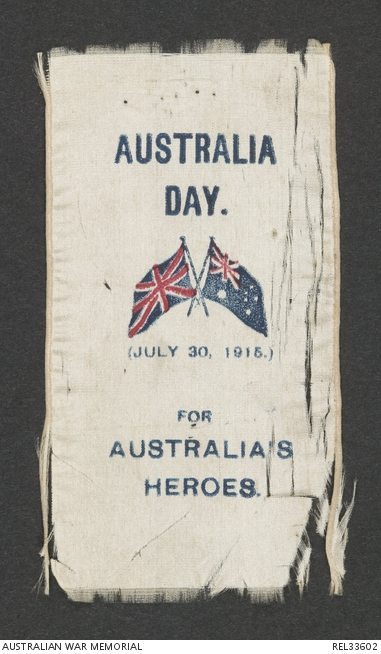
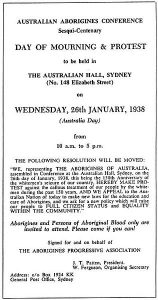
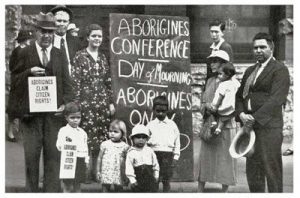 Australia Day and its commemoration on 26 January, has long been a controversial topic. This year has seen calls once again for the date to be changed. Similar calls have been made for a long time. As early as 1938, Aboriginal civil rights leaders declared a “Day of Mourning” to highlight issues in the Aboriginal community, particularly around celebration of the sesqui-centenary of the date that the First Fleet arrived to take possession of Australia. Interestingly enough, the date of 26 January was initially not universally accepted as the date for Australia Day.
Australia Day and its commemoration on 26 January, has long been a controversial topic. This year has seen calls once again for the date to be changed. Similar calls have been made for a long time. As early as 1938, Aboriginal civil rights leaders declared a “Day of Mourning” to highlight issues in the Aboriginal community, particularly around celebration of the sesqui-centenary of the date that the First Fleet arrived to take possession of Australia. Interestingly enough, the date of 26 January was initially not universally accepted as the date for Australia Day.
Before 1888, each colony had its own celebration of the founding of the colony, which was 26 January for New South Wales, making that date closely associated with New South Wales. Since Federation was officially marked as 1 January, there did not seem to be any point in making this day a public holiday, since it was already a public holiday for New Year’s Day. It was the events of the First World War, particularly Australia’s role in the Gallipoli conflict, which highlighted a need to celebrate patriotically and suggestions of public holidays to mark Australia and it’s contribution to the war effort. ANZAC day was born out of this fervour and it was also decided to celebrate an “Australia Day”. The Red Cross suggested that this occasion could be used to raise money for wounded soldiers, widows and orphans and an “Australia Day Fund” was started.
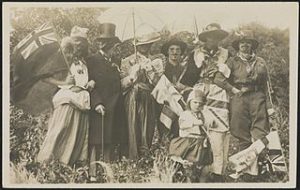 The Sydney Morning Herald of 17 June, 1915, announced that this was supported by the Premier of NSW, and various of his ministers. The date was set for this celebration for 30 July, 1915. Many states turned the celebration into a giant pageant or carnival, some incorporating it with the state’s agricultural Exhibition for that year. The day was celebrated on 28 July, 1916; 27 July, 1917 and 26 July, 1918. Each year the celebration got bigger, with cake stalls, refreshment stands, bands, concerts, demonstration sports, etc. and people dressed in a myriad of costumes. The fund-raising was a huge success too, with figures of £120,000 being mentioned – an enormous sum of money at that time!
The Sydney Morning Herald of 17 June, 1915, announced that this was supported by the Premier of NSW, and various of his ministers. The date was set for this celebration for 30 July, 1915. Many states turned the celebration into a giant pageant or carnival, some incorporating it with the state’s agricultural Exhibition for that year. The day was celebrated on 28 July, 1916; 27 July, 1917 and 26 July, 1918. Each year the celebration got bigger, with cake stalls, refreshment stands, bands, concerts, demonstration sports, etc. and people dressed in a myriad of costumes. The fund-raising was a huge success too, with figures of £120,000 being mentioned – an enormous sum of money at that time!
It was only in 1935 that all the states settled on 26 January as the date to mark Australia (and 3 years later that Aboriginal people announced their objections to this date). A range of other days have been suggested. These include:
19 January (which can be written as 19.01 – commemorating 1901, the year of Federation);
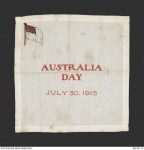 3 March (commemorating the Australia Acts 0f 1986, removing the appeal to Privy Council and diminishing the influence of the Queen);
3 March (commemorating the Australia Acts 0f 1986, removing the appeal to Privy Council and diminishing the influence of the Queen);
25 April (combining with ANZAC day);
8 May (a play on words, suggesting the epithet “Mate” – May-8)
9 May – opening of the first Federal Parliament;
27 May – marking the date of the 1967 referendum amending the constitution to include Aboriginal people;
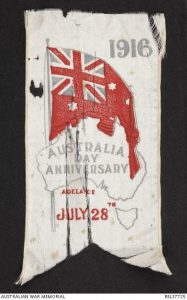 9 July – the date that Queen Victoria gave her royal assent to the Constitution of Australia, which allowed Federation to proceed;
9 July – the date that Queen Victoria gave her royal assent to the Constitution of Australia, which allowed Federation to proceed;
24 October – the date of Henry Parkes‘ speech on Federation at Tenterfield;
3 December – to commemorate the Eureka Stockade.
The range of possible dates available show that Australia has a rich history as a nation, which can be celebrated in a positive way. The initial celebrations, although within a context of war, were very positive in approach and made a positive contribution to segments of society badly needing support. Perhaps we can alter the focus of the modern celebration, incorporating some of these elements and acknowledging the different meanings different dates have for different parts of society? This might be a useful class discussion, examining the historical context around some of the issues raised above. Links to useful resources have been provided for teachers to explore some of these topics with their classes.


Since implementing this program I've really noticed how the students are improving.
Trent Perry, Teacher